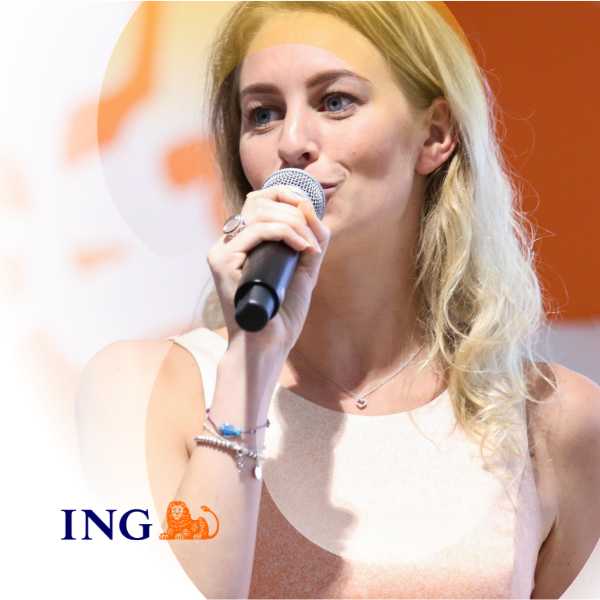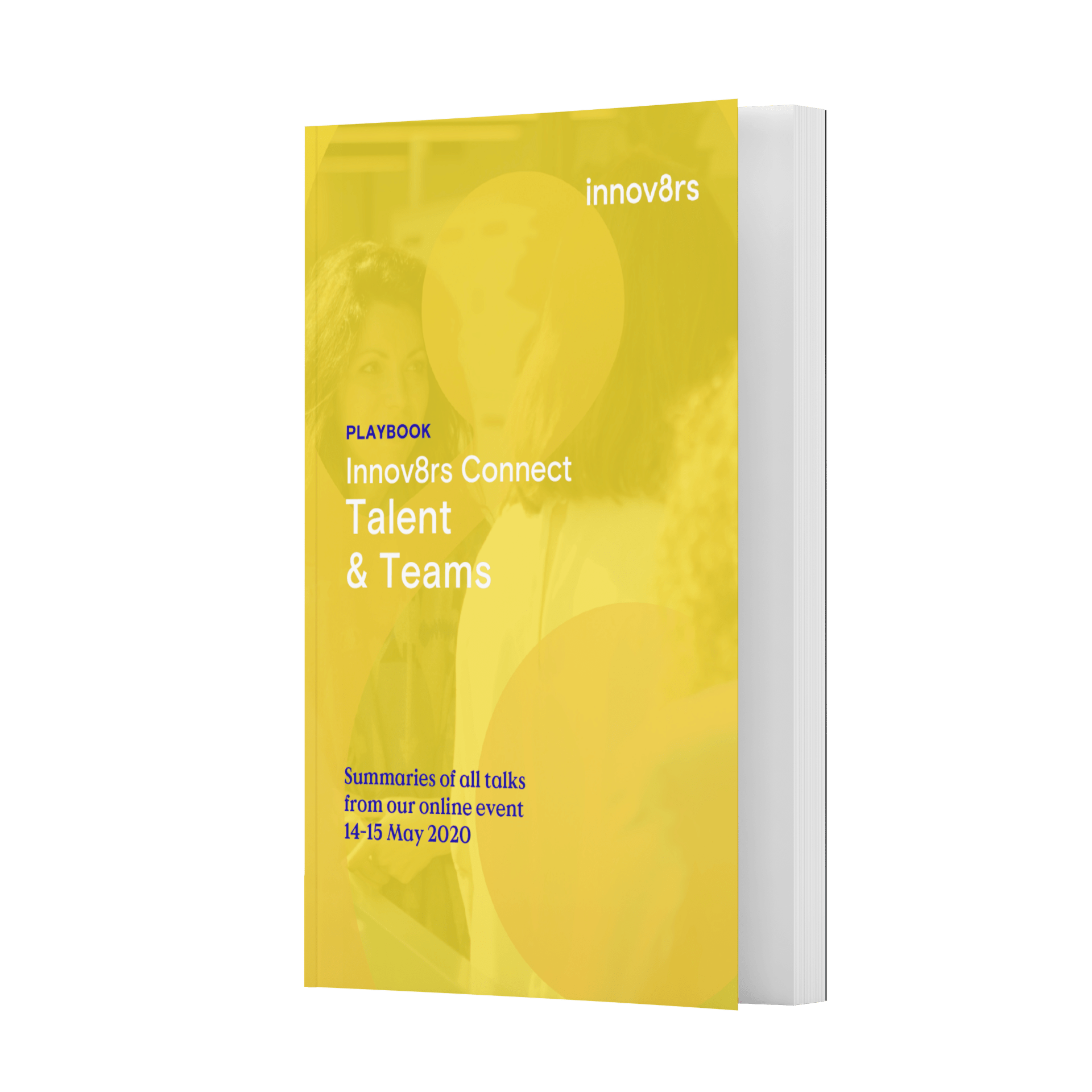At our recent Innov8rs Connect Talent & Teams online event, one of the key themes we discussed was teams.
What makes for effective innovation teams? How to engage people from the business in innovation? Beyond some enjoyable activities, how to collaborate with other functions for results?
Read on to understand how Nicholas Johnson (Medifast), Suzanne Vos (ING) and Simone van Neerven (Vueling Airlines) tackled that challenge.
Habits, Hi-5s and other lessons in teaming with 32k entrepreneurs
 Nicholas Johnson is the President of Coach and Client Experience for OPTAVIA a wholly owned subsidiary of Medifast.. When he joined the company, they wanted to transform a 40-year-old food manufacturer into a digital health and well-being brand with a mission to transform the world.
Nicholas Johnson is the President of Coach and Client Experience for OPTAVIA a wholly owned subsidiary of Medifast.. When he joined the company, they wanted to transform a 40-year-old food manufacturer into a digital health and well-being brand with a mission to transform the world.
Based on previous experience working with distributed workforces and entrepreneurs, he felt that there was a lot of hidden potential in a business channel that matched coaches with clients. With over 32,000 coaches within the system, he wanted to tap into the collective genius of that community.
Know Your WHY And Align Around It
The first thing the coaches did was to understand their client’s “why.” Why did they want to get healthy? What will it feel like to get healthy? The coaches asked very specific questions about what health looked like to that client.
Inside the company, they realized the “why” of the business needed to change. It was no longer about food or about good manufacturing processes. It was about reinforcing good habits across the community and becoming a better partner to the coaches.
The company now needed to find a common language between the business and the coaching community. They were using a language within the company that made it difficult for the community to understand, and vice versa. Establishing a common language allowed them to speak to each other without losing time or causing friction.
Nicholas wanted to empower the front lines, those within the company who had the closest contact with customers and get their feedback. He didn’t want to simply ask one-off questions, either, but instead establish it as a common habit. By listening more than talking, it dramatically changed the way the company operated and made them a more effective partner for coaches.
One Step At A Time
Nicholas points out that New Year’s resolutions often fail because people start too big. Instead, it’s about building up the micro habits needed to be successful. Starting small is better than starting big and then getting frustrated and failing, and it’s necessary to celebrate every early success. The coaches celebrated every 1% improvement their client made. In business, you’d take those results any day of the week.
Similarly, organizations don’t like to go down a path that looks too daunting and messy, so they never start the journey. Instead of allowing the mess to scare them, they need to look at the next 200 meters of road and just go. Don’t create stress by thinking too far ahead about what you don’t know. Teams will accomplish a lot more when they think 200 meters at a time.
PACE-ing Innovation at ING
 Suzanne Vos is the APAC Innovation Transformation lead at ING Labs. She established the innovation lab at ING in Singapore after working on the corporate banking side of the company. The innovation lab focuses on venture building and partnerships. She looks at it as working with 1% of the company that focus on opportunities beyond traditional banking and without limits.
Suzanne Vos is the APAC Innovation Transformation lead at ING Labs. She established the innovation lab at ING in Singapore after working on the corporate banking side of the company. The innovation lab focuses on venture building and partnerships. She looks at it as working with 1% of the company that focus on opportunities beyond traditional banking and without limits.
Since the beginning in 2018, they’ve incubated and supported several startups and the first are now spinning out of the Lab. Now that the innovation lab is up and running, Suzanne wanted to create something new again.
This time, instead of working with 1% of the company, she wants to work on transforming the 99%. These are the people at the core of the organisation who don’t have the opportunity to focus their energy on innovation 24/7.
She introduced the PACE methodology as a way to get the 99% to start innovating within those daily tasks.
Using PACE Methodology
The PACE methodology is ING’s way to innovate and it encompasses three different components:
1. Design Thinking: make sure you know who you are solving the problem for and do empathy work by stepping into their shoes.
2. Lean Startup: lowering your risk and building the smallest thing to validate what you are building is relevant. Work to build prototypes that test fast and fail fast.
3. Agile Scrum: the engine that’s driving the process through prioritisation and working in a multidisciplinary team.
The level of unknowns is different for venture building and business units. enture are exploring completely new territory. In business units, they already know where the problems are that need solving.
But the business units need to equip themselves with a way of working in both execution mode and search mode:
• Execution mode is working through the known. You know you are right, so you execute on a longer term roadmap.
• Search mode is going in the unknown. You assume you are wrong, so you use a weekly roadmap that follows the evidence you uncovered the week before.
PACE helps teams operate in search mode.
Creating Innovation Menu Items
After two months of training people in business units in the PACE methodology, Suzanne didn’t see innovation happening. She brought people back in and asked what was preventing them from innovating. It came down to the fact that innovation wasn’t anyone’s responsibility as it was not in their KPIs. That meant there were no clear targets, and that’s what they needed.
So she gave them tangible targets about how to introduce innovation as part of their job through the form of Innovation Menu Items.
Some of those items include:
• Innovation trainer: This led to the development of a small group of people who train the masses in the innovation methodology.
• Innovation community manager: These people work with those who have innovation in their KPIs.
• Pop-up squad: People from different backgrounds and disciplines look at how to come together and take on a problem.
For innovators, this worked. It gave them a tangible goal to work towards and something they could communicate to others.
Validating With Senior Management
Senior management was supportive of the menu items but were unsure about how they could evaluate the performance of innovators. Suzanne realized that to gain the support of the senior management team, she would need to create a measurability framework.
She did, using inspiration from two concepts- OKR’s and Innovation Accounting.
Innovation accounting would measure activity and progress. That is important because innovation takes a long time to result in ROI. This system wouldn’t penalize people while they are working towards the long-term results of their innovation efforts. The senior management team embraced the measurability framework and rolled it out for multiple disciplines such as Sustainability and CSR worldwide.
In conclusion, Suzanne shared three recommendations:
• Training is important, but the environment needs to enable
• Innovators need specific goals to get started
• Measurability is key for senior management support
Innovation Teams: From Values to Value
 Simone van Neerven is the founder of reBel.la. After a long career at KLM Royal Dutch Airlines where she achieved success after success by building strong teams, early 2018 she quit and founded her own company. She now supports organizations in their innovation and employee engagement journey.
Simone van Neerven is the founder of reBel.la. After a long career at KLM Royal Dutch Airlines where she achieved success after success by building strong teams, early 2018 she quit and founded her own company. She now supports organizations in their innovation and employee engagement journey.
She took her first assignment as Vueling Airlines’ head of innovation. She also helps CHANEL in Paris with their innovation strategy. Simone is not afraid to take up big challenges and is seen as a hands on, curious and a creative maverick. She enjoys working with people that dream big, know how to have fun, and get things done. She shares the values she used to build the innovation team at Vueling Airlines.
Reframing What You Do Requires a Rebellious Mindset
It’s up to innovation teams to bring a new perspective. For example, the aviation industry is always talking about planes, but the business isn’t really about planes. It’s about people.
That led to them reframing the company mission:
We don’t fly planes, we fly people.
Reframing what the business did helped to open up the minds of their colleagues.
Service designers began talking, listening, and observing customers. They also included colleagues in their research, as they were the direct connection to the customers. The team then came back to the office and mapped their observations in a service blueprint. Service blueprints bring the customer journey with the operational journey together. This helped the innovation team plot out the bottlenecks in the business.
Simone encouraged her team to fall in love with the problem, not the solution. Sometimes teams find a solution that’s not solving a problem. When you fall in love with the problem, though, there is a determination to solve it.
In The Clouds
A lot of innovation is about focusing on the here and now, but you need to have your head in the clouds at the same time. Simone’s team did this for instance by thinking about what the future airport experience will be like in 2025. They animated their ideas to make them tangible to their colleagues.
Then the innovation lab experimented with everything in the animation, such as the use of facial recognition at the airport. It helped engage people in innovation company-wide, and encouraged them in futures thinking.
Often, an innovation team has to pull heads out of the sand. Once Simone’s team was able to get people open to new ideas, bigger things began to happen. It’s innovators who need to ask provoking questions about whether systems can continue. For example, within the aviation industry, Simone’s team asked:
• What will flying look like in the future? It’s no longer glamorous to fly. Should it be? How should it look now?
• Who are the real competitors? Is competition really about finding a cleaner way to fly? Or is the real competition going to be trains and hyperloops?
Never Play a Zero-Sum Game
Corporations can be very siloed. Simone used the innovation lab to bring people from different teams all over the company together, including some customers. It gave them direct feedback on the value of their ideas, led to more fresh ideas, and created ambassadors for their innovations at the same time.
When you get a punch from the business, never punch back. Always try to collaborate and remember it’s always possible to find a win/win solution. It’s a matter of looking at things differently and trying to determine how you can help each other.
The pace in innovation is always high. So it’s important to slow down occasionally with your teams and reflect. Slowing down doesn’t mean sitting down, though. Simone’s team used those slow times to get comfortable being uncomfortable, getting out of their comfort zones. Moreover, Simone hired people with a growth mindset and would ask those without one to leave. Average teams produce average results, so go for a crazy team with some daredevils.
Remember that teams are always about people, so have fun. Loads of it.
Playbook Innov8rs Connect - Talent & Teams
Get all summaries of 21 sessions from our recent online event Innov8rs Connect Talent & Teams on 14-15 May 2020 in one 80+ pages Playbook.


